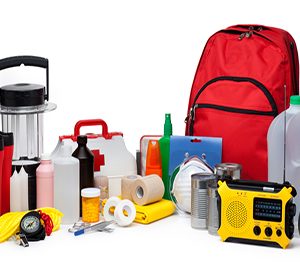
Emergency kits don’t have to be expensive, but being prepared can save your life. First, create a family emergency communication plan. This should include phone numbers and meeting places. Phones may not work, so all family members, local emergency contacts and out-of-state emergency contacts should be listed. Everyone in the household should know where to meet and who may need to be picked up from school or work. Write this information down and keep it in the emergency kit. Each member of the household should have a copy as well (it can be kept in wallets, backpacks, etc…).
Kit basics include:
- Water (one gallon of water per person per day); it is recommended to keep 5-7 days’ worth
- 5-gallon water container
- Food (non-perishable items that can be eaten cold such as canned food, granola bars, etc…)
- First-Aid kit (Band-Aids, gauze, scissors, pain relief products, safety pins, Q-tips and cotton balls)
- Flashlights and batteries
- Blankets
- Radio and batteries
- Cash (ATM’s may not work)
- Wrench (used to turn off the gas main and the waterline to your hot water tank)
- Hammer
- Small handsaw (can be used to cut up wood to make a fire)
- Plastic zip-lock bags (to make things waterproof)
- Eye protection
- Dust mask – N95
- Work gloves
- Trash bags
- Hygiene products – travel sizes (i.e. deodorant, toothbrush, toothpaste, hairbrush, feminine products)
- Rope
- Duct tape
- Large backpack/duffle bag/old suitcase
- Toilet paper (min. 2 rolls)
- Rain poncho/coat
- Matches or lighter
- Extra clothes
The above are only suggestions to get you started. Each emergency kit will be specific to your household. For example, if you have a pet, then you need to pack extra water and pet food. If there is a baby in the household, don’t forget diapers and baby food.
For training and education opportunities on emergency preparedness by the City of Goleta please click here.

